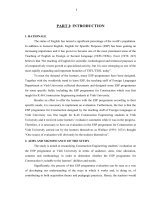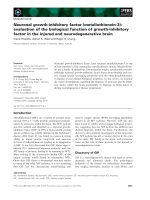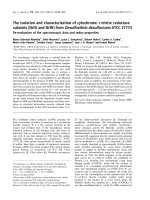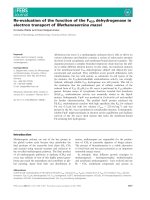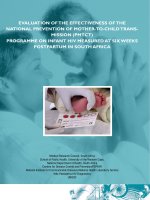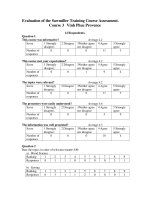Construction engineering students' evaluation of the esp programme at vinh university
Bạn đang xem bản rút gọn của tài liệu. Xem và tải ngay bản đầy đủ của tài liệu tại đây (493.28 KB, 44 trang )
PART I: INTRODUCTION
1. RATIONALE
The status of English has turned a significant percentage of the world’s population. In
addition to General English, English for Specific Purposes (ESP) has been gaining an
increasing importance and it has grown to become one of the most prominent areas of the
Teaching of English as Foreign or Second Language (TEFL/TESL). Ewer (1976: 247)
believes that “the teaching of English for scientific, technological and technical purposes is
of comparatively recent growth as specialized activity, but it is now emerging as one of the
most rapidly expanding and important branches of TEFL/TESL today”.
To meet the demand of the learners, many ESP programmes have been designed.
Together with the worldwide trend to learn ESP, the teaching staff of Foreign Languages
Department at Vinh University collected documents and designed some ESP programmes for
some specific fields, including the ESP programme for Construction which was first taught
for K.46 Construction Engineering students at Vinh University.
Besides an effort to offer the learners with the ESP programme according to their
specific needs, it is necessary to implement an evaluation. Furthermore, the fact is that the
ESP programme for Construction designed by the teaching staff of Foreign Languages at
Vinh University was first taught for K.46 Construction Engineering students at Vinh
University and it received some learners’ evaluative comments while it was in the progress.
Therefore, it is necessary to have an evaluation on the ESP programme for Construction at
Vinh University carried out by the learners themselves as Wallace (1991: 163)‘s thought
“One source of evaluation will obviously be the trainees themselves”.
2. AIMS AND SIGNIFICANCE OF THE STUDY
The study is aimed at researching Construction Engineering students’ evaluation on
the ESP programme at Vinh University in terms of audience, aims, time allocation, contents
and methodology in order to determine whether the ESP programme for Construction is
suitable to the learners’ abilities and needs.
Significantly, the process of this ESP programme evaluation can be seen as a way of
developing our understanding of the ways in which it works and, in doing so, of contributing
to both acquisition theory and pedagogic practices. Hence, the teachers would find ways to
1
do interesting things in their teaching ESP in order to realize all the potentials embedded in
the programme.
It is hoped that the findings of this study and some suggestions would contribute in
improving the ESP programme for Construction at Vinh University to make it more suitable
for the learners’ needs and abilities in the coming years.
3. RESEARCH QUESTIONS
The study aims to find out the answers to the following questions:
1) What are the learners’ evaluative comments on the ESP programme for
Construction at Vinh University?
2) What are the learners’ needs for learning ESP at Vinh University?
3) How should the ESP programme for Construction at Vinh University be improved
to make it more suitable to the learners’ abilities and needs?
4. METHOD OF THE STUDY
This minor thesis uses a number of books concerning ESP and evaluation. The
research method used is the survey. The data collection instrument is questionnaire. The
practical data from K46 Construction Engineering students at Vinh University forms basis
for this study.
5. SCOPE OF THE STUDY
Within its scope, this research mainly focuses on the learners’ evaluation of the ESP
programme at Vinh University such as: the time allocation, the topics of the ESP reading
texts, the length of the ESP reading texts, the amount of technical vocabulary contained in
each ESP reading text, the level of difficulty in grammar, the usefulness of exercises, the
most difficult type of exercises, the satisfaction towards practice through exercises, the
achievements after finishing the programme, and the satisfaction towards needs after
finishing the programme.
Basing on the findings and the learners’ needs, it provides some suggestions to
improve the ESP programme for Construction at Vinh University.
Its major object is K46 Construction Engineering students of Technology Department
at Vinh University.
2
6. DESIGN OF THE STUDY
The minor thesis is composed of three main parts: introduction, development and
conclusion.
The introduction presents the rationale, aims and significance, research questions,
method of the study, scope of the study, as well as design of the study.
The development consists of three chapters:
- Chapter I, “Literature Review”, provides the relevant theories: an overview of ESP
(definition of ESP, classification of ESP and the development of ESP), evaluation
(terminology definition, types of programme evaluation, purposes for evaluation, criteria for
evaluation and central questions in programme evaluation design) and learner-centeredness
in ESP.
- Chapter II, “An overview of English for Construction at Vinh University”, presents
background information about English for Construction at Vinh University, including in the
teaching and learning situation, a description of current ESP programme for Construction and
the learners at Vinh University.
- Chapter III, “The study”, describes the methodology employed to collect data for
this thesis at first (participants, data collection instrument and procedure). Then it reports on
the learners’ evaluation of the ESP programme for Construction at Vinh University and their
needs, and shows the major findings. Finally, it provides some suggestions to improve the
ESP programme for Construction at Vinh University.
The conclusion presents what have been found out from the study and the limitations
and suggestions for further study.
3
PART II: DEVELOPMENT
CHAPTER 1: LITERATURE REVIEW
This chapter aims to provide a theoretical base to develop an operational framework
for programme evaluation. The first part presents an overview of ESP with regards to
definition, the classification and the development of the ESP. The second part discusses
about evaluation, concerning in terminology definition, types of programme evaluation,
purposes for evaluation, criteria for evaluation and central questions in programme
evaluation design. The third part relates to the learner-centeredness in ESP.
1.1. AN OVERVIEW OF ESP
1.1.1. Definition of ESP
ESP has been defined by different researchers as well as scholars’ different views.
According to Hutchinson and Waters (1987: 19), ESP must be seen as an approach,
not as a product. In their opinion, ESP is not a particular kind of language or methodology,
nor does it consist of a particular type of teaching material.
However, Strevens (1988) defines ESP by making a distinction between four
absolute characteristics and two variable characteristics:
- The absolute characteristics are that ESP consists of ELT (English Language
Teaching) which is:
• designed to meet specified needs of the learners;
• related in content (that is in its themes and topics) to particular disciplines,
occupations and activities;
• centred on language appropriate to those activities in syntax, lexis,
discourse, semantics and so on, and analysis of the discourse;
• in contrast with ‘General English’.
- The variable characteristics are that ESP
• may be restricted as to the learning skills to be learned (for example
reading only);
• may not be taught according to any pre-ordained methodology.
4
(Source: Strevens, 1988; cited in Dudley-Evans and St John, 1998: 3)
Robinson (1991) ‘s definition (cited in Dudley-Evans and St John, 1998: 3) is based
on two key defining criteria (i.e. ‘normally goal-directed’ and need analysis) and a number
of characteristics (i.e. limited time period, adults in homogeneous classes) that are generally
found to be true of ESP.
Dudley-Evans and St John (1998: 4-5) comment that above definitions have validity
but also weaknesses, either in the definition or in the features described. They believe that a
definition of ESP should reflect the fact that much ESP teaching, especially where it is
specifically linked to a particular profession or discipline, makes use of a methodology that
differs from that used in General Purpose English teaching. They also believe that language
should be included as a defining feature of ESP.
In summary, all the above definitions show that ESP belongs to English Language
Teaching (ELT). The ESP courses are performed successfully in occupational roles by an
individual or a group whose need is considered to be a distinguished feature from General
English.
1.1.2. Classification of ESP
ESP has traditionally been divided into two main areas: English for Academic
Purposes (EAP) and English for Occupational Purposes (EOP).
According to Robinson (1991), the classification of ESP is generally presented in a
tree diagram as follows:
Pre-experience
EOP Simultaneous / In-service
Post-experience
ESP Pre-study
For study in a In study
specific discipline Post-study
EEP/EAP Independent
As a school subject
Integrated
Figure 1: ESP classification by experience (Robinson, 1991: 3-4)
5
The diagram shows a useful division of courses. Those distinctions are very
important and they will affect the degree of specificity that is appropriate to the course.
Dudley-Evans and St John (1998) also present the classification of ESP through a tree
diagram but it divides EAP and EOP according to discipline or professional area as in the
figure 2.
English for Specific Purposes
English for Academic Purposes English for Occupational Purposes
English for English for English for English for English for English for
(Academic) (Academic) (Academic) Management, Professional Vocational
Science and Medical Legal Finance and Purposes Purposes
Technology Purposes Purposes Economics
English for English for Pre- Vocational
Medical Business Vocational English
Purposes Purposes English
Figure 2: ESP classification by professional area (Dudley-Evans and St John 1998: 6)
The tree diagram for ESP by Dudley-Evans and St John (1998) describes that EAP
consists of English for Science and Technology (EST), English for Medical Purposes (EMP)
English for Legal Purposes (ELP) and English for Management, Finance and Economics.
And EOP includes English for Professional Purposes with sub-sections as English for
Medical Purposes (EMP) and English for Business Purposes (EBP) and English for
Vocational Purposes with sub-sections as Pre-Vocational English and Vocational English.
In short, studying various ways of classifying ESP provides a teacher an overall
picture of the groups of learners with whom he or she is going to work.
1.1.3. The development of ESP
Hutchinson and Waters (1987: 9-14) refer to five stages of the development of ESP
from the early beginnings in the 1960s. They point out that ESP is not a monolithic universal
phenomenon and develops at different speeds in different countries.
The first stage, which took place mainly in the 1960s and early 1970s, is
characterized by the register analysis or the concept of ESP as a special language. The basic
6
principle of this concept is that the English of Electrical Engineering constitutes a specific
register different from that of Biology or General English and the aim of the analysis is to
identify the grammatical and lexical features of these registers. Teaching materials then take
these linguistic features as their syllabus. English for different purposes has different
registers, and the aim of the analysis is to identify the grammatical and lexical features of
these registers. A good example of a syllabus is “A Course in Basic Scientific English” by
Ewer and Latorre (1969) and their aim is to produce a syllabus which gives high priority to
the language forms students meet in their Science studies and low priority to forms students
do not meet.
Whereas in the first stage of its development, ESP focuses on language at the
sentence level, the second stage of development shifts attention to the level above the
sentence with the emerging field of discourse or rhetorical analysis. Attention shifts to
understanding how sentences are combined in discourse to produce meaning. Therefore, the
concern of research is to identify the organizational patterns in texts and to specify the
linguistic means by which these patterns are signaled. These patterns will then form the
syllabus of the ESP course.
The third stage is characterized by the target situation analysis. The most thorough
explanation of the target situation analysis is the system set out by John Munby in
“Communicative Syllabus Design” (1978). The Munby model produces a detailed profile of
the learners’ needs in term of communication purposes, communicative setting, the means of
communication, language skills, functions, structures, etc. And the target situation analysis
stage marks a certain ‘coming of age’ for ESP. What it aims to do is to take the existing
knowledge and set it on a more scientific basis, by establishing procedures for relating
language analysis more closely to learners’ reasons for learning. This stage also marks a
significant change is that the purpose of an ESP course is to enable learners to function
adequately in a target situation in which the learners will use the language they are learning.
Unlike the above three stages of the development of ESP, mainly looking the analysis
of the learners’ need at the surface linguistic features of the target situation, the fourth stage
of ESP attempts to look below the surface and to consider not the language itself but the
thinking processes that underlie language use. This stage is characterized by skills and
strategies. Hutchinson and Waters (1987: 13) point out a great influence of researchers’
works (Françoise Grellet (1981)’s, Christine Nuttall (1982)’s and Charles Alderson and
7
Sandy Urquhart (1984)’s) on developing strategies for reading skills for the teaching of ESP.
The principal idea behind the skills-centred approach is that underlying all language use there
are common reasoning and interpreting processes, which, regardless of the surface forms,
enable us to extract meaning from discourse. There is, therefore, no need to focus closely on
the surface forms of the language. The focus should rather be on the underlying interpretive
strategies, which enable the learner to cope with the surface form, for example guessing the
meaning of words from context, using visual layout to determine the type of the text,
exploiting cognates (i.e. words which are similar in the mother tongue and the target
language) etc.
The fifth stage of ESP development is characterized by the learning-centred
approach which is concerned with “language learning”. The learning-centred approach is
based on the assumption that describes and exemplifies what people do with language will
enable someone to learn it. This is an importance of ESP like Hutchinson and Waters (1987:
14) say: “A truly valid approach to ESP must be based on an understanding of the processes
of language learning”.
In summary, ESP undergoes five stages of the development with various
characteristics for each stage. The examples of all approaches which were described above
can be found operating somewhere in the world at the present time.
1.2. EVALUATION
1.2.1. Terminology definition
There are many definitions of evaluation. Fundamentally, evaluation is asking
questions and acting on the responses.
Rea-Dickins and Germaine (1992: 3- 4) believe that evaluation is an intrinsic part of
teaching and learning. It is important for the teacher because it can provide a wealth of
information to use for the future direction of classroom practice, for the planning of courses,
and for the management of learning tasks and students. Evaluation is also considered as a
‘natural activity’; something that is very much part of our daily existence and it can be very
formal or informal. It is also something that may not always be made explicit but may
actually be undertaken unconsciously.
Dudley-Evans and St John (1998: 128) define that “Evaluation is a whole process
which begins with determining what information to gather and ends with bringing about
8
change in current activities or influencing future ones”. They believe that evaluation must be
more than collecting and analyzing data. They describe evaluation as formative or
summative. Evaluation which takes place during the lifetime of an activity /a course and the
findings help to shape the course during its life-time is called formative evaluation.
Summative evaluation takes place at (or after) the end of an activity and so does not
influence that version of the activity. Its purpose is to assess impact and to provide
information that can be fed into repeat versions or related activities. Therefore, summative
evaluation is valuable for durable courses.
Hedge (2000: 351) refers to the term “evaluation” as “the assessment of students at
the end of a course, but in recent years its meaning has widened to include all aspects of a
programme”. Evaluation can relate to courses and learners in a number of ways: (1) It can try
to judge the course as it is planned; (2) It can try to observe, describe, and assess what
actually happening in classroom as a course progresses; (3) It can test what learners have
learned from a course.
In summary, evaluation relates to courses and learners. It has been widened to include
the aspects of a programme and it should be carried out at the end of the courses. The aspect
of the programme which is chosen to evaluate depends on the purpose of the evaluation.
1.2.2. Types of programme evaluation
According to Stufflebeam (1971), there are four types of programme evaluation
which are identified as: context evaluation, input evaluation, process evaluation and product
evaluation
The table below is the CIPP model for programme evaluation by Stufflebeam (1971).
9
Table 1: The CIPP model for programme evaluation
Context evaluation Input evaluation Process evaluation Product evaluation
Objective
To define the institutional context, to
identify the target population and assess
their needs, to identify opportunities for
addressing the needs, to diagnose
problems and to judge if proposed
objectives are sufficiently responsive to
assessed needs.
To identify and assess system
capabilities, alternative
programme strategies,
procedural design for
implementing the strategies,
budges and schedules.
To identified and predict, in
process, defects in the procedural
design or its implementation; to
provide information for
preprogrammed decision, and to
record and judge procedural
events and activities.
To collect descriptions and
judgements of outcomes, and
to relate them to objectives
and context, input, and
process information to
interpret their worth and
merit.
Method
By using such methods as system
analysis, survey, document review,
hearing, interviews, diagnostic tests and
the Delphi
b
technique.
By inventorying and analyzing
available human and material
resources, solution strategies
and procedural designs for
By monitoring the activity’s
potential procedural barriers and
remaining alert to unanticipated
ones, by obtaining specific
By defining operationally and
measuring outcome criteria,
by collecting judgements of
outcomes from stakeholders,
10
relevance, feasibility, and
economy. And by using such
methods as literature search,
visits to exemplary
programme, advocate teams,
and pilot trials.
information for programmed
decisions, by describing the
actual process and by continually
interacting with and observing
the activities of project staff.
and by performing both
qualitative and quantitative
analyses.
Relation to decision marking in the change process
For deciding on the setting to be served,
the goals associated with meeting needs
or using opportunities, and the
objectives associated with solving
problems, i.e., for planning needed
changes. And to provided a basis for
judging outcome.
For selecting sources of
support, solution strategies, and
procedural design, i.e., for
structuring change activities.
And to provide a basis for
judging implementation.
For implementing and refining
the programme design and
procedure, i.e., for effecting
process control. And to provide a
log of the actual process for later
use in interpreting outcomes.
For deciding to continue,
terminate, modify, or refocus
a change activity. And to
present a clear record of
effects (intended and
unintended, positive and
negative).
b
A procedure in which a set of questions or tasks is sent out to experts in the field. The collective responses are then collated and
analysed.
(Source: Stufflebeam, 1971; cited in Nunan, 1992: 194-195 )
11
Tomlinson (1998) divides programme evaluation into macro- and micro-evaluation as
follows:
task evaluation of evaluation of
evaluation, sequencing levels of
etc. practice, ect. participation
etc.
Figure 3: Macro- and micro-evaluation in language teaching (Tomlinson, 1998: 219)
It is necessary for the evaluator to study the types of programme evaluation because it
can help him or her decide what type of evaluation he or she would like to conduct in
specific situations and for purposes of evaluation.
1.2.3. Purposes for evaluation
Evaluation plays a very important role in the improvement of a language programme.
There is no language programme which can be completely useful to all teaching situations.
Evaluation is a matter of judging the fitness of something for a particular purpose,
and then it is concerned with relative merit. Hutchinson and Waters (1987: 96) emphasizes
that “There is no absolute good or bad – only degrees of fitness for the required purpose”. In
any kind of evaluation, the decision finally made is likely to be the better for being based on
a systematic check of all the important variables. Hutchinson and Waters (1987: 97) also
believe that a careful evaluation can save a lot of expense and frustration.
12
Program /
project
evaluation
Administrative
matters
Macro-
evaluation
Micro-
evaluation
timetable
evaluation,
etc.
Curricular
matters
Materials
evaluation
Teacher
evaluation
Learners
evaluation
Rea-Dickins and Germaine (1992) identify a number of different purposes for
evaluation. They divide evaluation into two broad categories: general purposes; and specific,
topic-related purposes.
- For general purposes of evaluation, Rea-Dickins and Germaine (1992) refer to three
principal reasons for which evaluation may be undertaken as follows:
1. accountability
2. curriculum development and betterment
3. self-development: teachers and other language teaching professionals.
(Rea-Dickins and Germaine, 1992: 23)
In their discussion about the general purposes of evaluation, they emphasize
that evaluation for purposes of accountability is mainly concerned with determining
whether there has been value for money; Evaluation for purposes of curriculum
development will involve information from teachers and other relevant ELT
professionals; Evaluation for purposes of teacher self-development involves in
describing and better understanding the teachers’ own contexts with a view to
improving the teaching.
- For specific, topic-related purposes of evaluation, Rea-Dickins and Germaine
(1992) consider evaluation as the means by which we can gain a better understanding
of what is effective, what is less effective, and what appears to be of no use at all.
Hedge (2000: 352) refers to the purposes of evaluation are for accountability and for
development. The purpose which evaluates for accountability is to make staff and / or
institutions answerable to authorities and / or sponsors and evaluation for development aims
at improving to the current programme as well as to future programme.
In summary, it is necessary to evaluate aspects of a language programme in order to
understand how the programme works and how successfully it works. The results of
evaluation enable the different kinds of decision to be made about the programme, such as: to
decide whether to continue the programme or not or to improve the programme to make it
more useful.
13
1.2.4. Criteria for evaluation
1.2.4.1. Criteria defined by Hutchinson and Waters (1987)
Hutchinson and Waters (1987: 99-104) suggest five evaluation criteria for objective
and subjective analysis which are summarized as follows:
- Audience: the learners and the materials intended for.
- Aims: the aims of the course and the aims of the materials.
- Content: language description, language points, proportion of work on each macro-
skill, micro-skills, text-types, subject-matter area(s) (level of knowledge, types of
topics, treatment), organization of content within the course units, sequence of
content throughout the course, sequence of content within a unit.
- Methodology: theory/ies of learning, aspects of the learners’ attitudes to /
expectations about learning, kinds of exercises/tasks, teaching-learning techniques,
aids, guidance/support for teaching the course, the flexibility.
- Other criteria: price, quantities, availability.
1.2.4.2. Criteria defined by Sheldon (1988)
Sheldon (1988) (cited in Hedge, 2000: 367-371) presents the list of evaluation criteria
including: rationale, availability, user definition, layout/graphics, accessibility, linkage,
selection/grading, physical characteristics, appropriacy, authenticity, sufficiency, cultural
bias, education validity, stimulus/practice revision, flexibility, guidance, and overall value for
money.
1.2.4.3. Criteria defined by Ur (1996)
Ur (1996: 184) lists as examples of general criteria and specific criteria: general
criteria (i.e. clear layout and print, provides periodic review or test sections) and specific
criteria (i.e. attractive and colourful illustrations (which may be particularly relevant for
younger learners), vocabulary and texts relevant to topic (if the materials are intended for
students of science and technology)).
1.2.4.4. Criteria defined by Tomlinson (1999)
Tomlinson (1999, cited in McGrath, 2002: 32) takes the definition of criteria a step
further, suggesting four categories of specific criteria: (1) Media-specific criteria (i.e. those
which related to the particular medium used. In reference to audio-recorded material, for
instance, one might consider the audibility of the recording; (2) Content-specific criteria (i.e.
14
those which related to the nature of the material, such as the choice of topics, situations or
language in a business English book or the texts included and skills covered in a book
focusing on the development of reading skills; (3) Age-specific criteria (i.e. the suitability of
the material (e.g. visuals, cognitive challenge) for the age-group for which it is intended); (4)
Local criteria (i.e. the appropriateness of the material for the particular environment in which
it is to be used).
1.2.4.5. Criteria defined by McGrath (2002)
McGrath (2002: 32-33) discusses criteria for evaluation to be “from general to
specific”. In his view, one way of thinking about general criteria is as headings or ways of
summarizing sets of more specific criteria and the specific criteria can only be determined on
the basis of individual circumstances. He sets out a possible basic set of such criteria which
consists of: Practical considerations (all components available; affordable; multi-level);
Support for teaching and learning (additional components (teacher’s book, tests, cassettes),
suitable or self-study); Context-relevance (suitable for course (length of course, aims of
course, syllabus, exam), suitable for learners (age, level, cultural background), suitable for
teacher, required resources available, evidence of suitability); Likely appeal to learners
(layout, visuals, topics, suitable over medium term).
In short, studying criteria is very important when an evaluation is carried out. One
essential issue is that a wide variety of relevant and appropriate criteria for the evaluation of
the ESP programme should be established and applied to evaluate the suitability of the
programme to the learners’ needs and abilities.
1.2.5. Central questions in programme evaluation design
Nunan (1992: 196) makes a list of questions which needs to deal with some practical
issues in programme evaluation as follows:
• What is the purpose of the evaluation?
• Who is the audience for the evaluation?
• What principles of procedure should guide the evaluation?
• What tools, techniques, and instruments are appropriate?
• Who should carry out the evaluation?
• When should it be carried out?
• What is the time frame and budget for the evaluation?
15
• How should the evaluation be reported?
It is useful to studying Nunan ‘s (1992) central questions in programme evaluation
design before evaluating so that all factors that need evaluating will be covered.
1.3. LEARNER-CENTEREDNESS IN ESP
1.3.1. Learner-centered approach
Hutchinson and Waters (1987: 19) state ESP as “an approach”, not as “a product” to
stress the commonality of the language and learning in which the learners are centered. The
learner-centered approach is based on the principle that learning is totally determined by the
learner. Learning is seen as a process in which the learners use what knowledge or skills they
have in order to make sense of the flow of new information. Learning, therefore, is an
internal process, which is crucially dependent upon the knowledge the learners already have
and their ability and motivation to use it. Learning should be seen in the context in which it
takes place. Learning is not just metal process; it is a process of negotiation between
individuals and society. Society sets a target (in the case of ESP, performance in the target
situation) and the individuals must do their best to get as close to that target as is possible (or
reject it). The learners will certainly determine their own route to the target and the speed at
which they travel the route, but that does not make the target unimportant. The target still has
a determining influence on the possible routes. Hutchinson and Waters (1987:19) emphasize
that ESP is understood properly as an approach to language learning, which based on learner
need.
Historically, approaches to course design were developed from language-
centeredness to skill-centeredness and then to learner-centeredness. Hutchinson and Waters
(1987: 72-76) make a comparison about the approaches to course design to show the
embracing feature of the learner-centered approach: A language-centered approach only
determines the ESP course as the nature of the target situation performance; A skill-centered
approach determines the ESP course as the nature of the target situation performance and
looking behind the target performance data to discover what processes enable someone to
perform; A learner- centered approach determines the ESP course as the nature of the target
situation performance, looking behind the target performance data to discover what processes
enable someone to perform, and looking beyond the competence that enables someone to
16
perform, because what we really want to discover is not the competence itself, but how
someone acquires that competence.
1.3.2. Learner-centered courses
The learner-centered courses are different from other courses. These courses pay
greater attention to the process of learning and they allow for learners’ preference on what
should be taught.
Brumfit (1984: 7) states that an ESP course is a direct factor concerning with
purposes of the learners: “First, it is clear that an ESP course is directly concerned with the
purpose for which learners need English, purposes for which are usually expressed in
functional terms. ESP fits firmly within the general movement towards ‘communicative’
teaching of the last decade or so”. Any learner learns for his or her own purposes. He or she
wants to learn what he or she needs. That appears more clearly in ESP learning. The ESP
learners aim to learn about their specific fields.
Hutchinson and Waters (1987: 16) distinguish ESP courses by the general nature of
the learners’ specialism and they divide ESP into three large categories basing on the
learners’ specialism: EST (English for Science and Technology), EBE (English for Business
and Economics) and ESS (English for the Social Sciences).
Nunan (1988) develops the learner-centered courses within an adult ESP context
basing on the principles of learner-centeredness. He assumes that “in most learning context,
it is impossible to teach learners everything they need to know in classes. Little class time
therefore must be used effectively to teach those aspects of the language which the learners
consider to be ‘mostly urgently required’” (Nunan, 1988: 3).
Schleppegrell (1994: 233)’ opinion about the learners in an ESP course is to bring to
class a reason for learning English and a real life context for its use; the learners should have
knowledge of the specific vocation the course is addressing and well-developed learning
strategies.
In summary, chapter I has presented an overview of ESP and evaluation. The
purposes for evaluation, criteria for evaluation central questions in programme evaluation
design and the learner-centered in ESP imply that those are issues to carry out a programme
evaluation in which the learners are centered.
17

